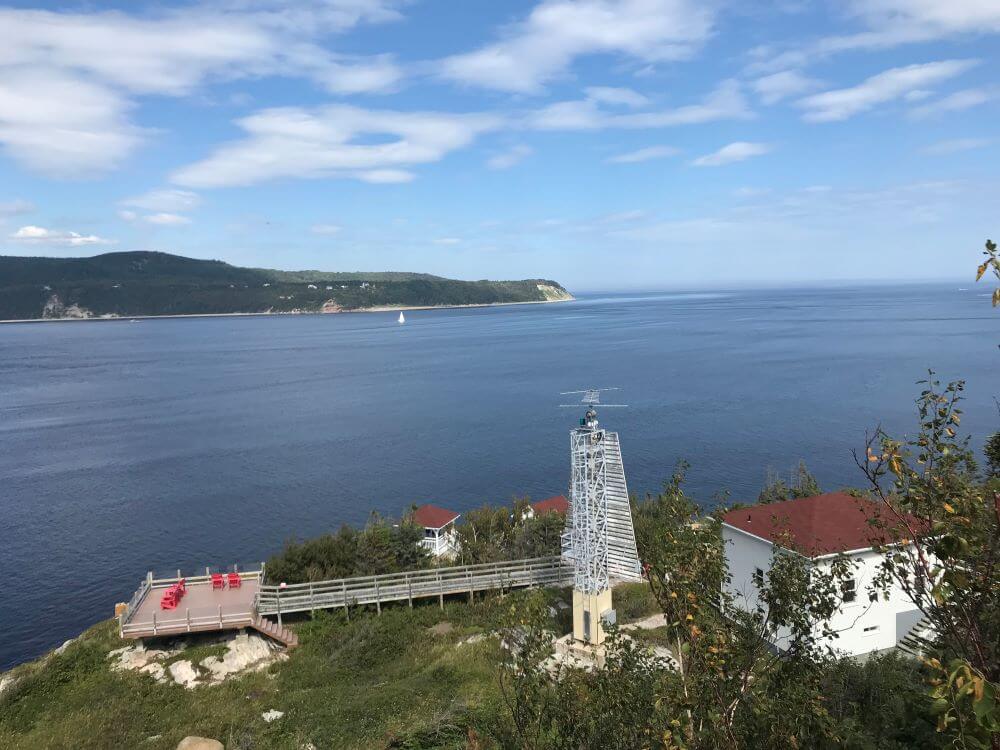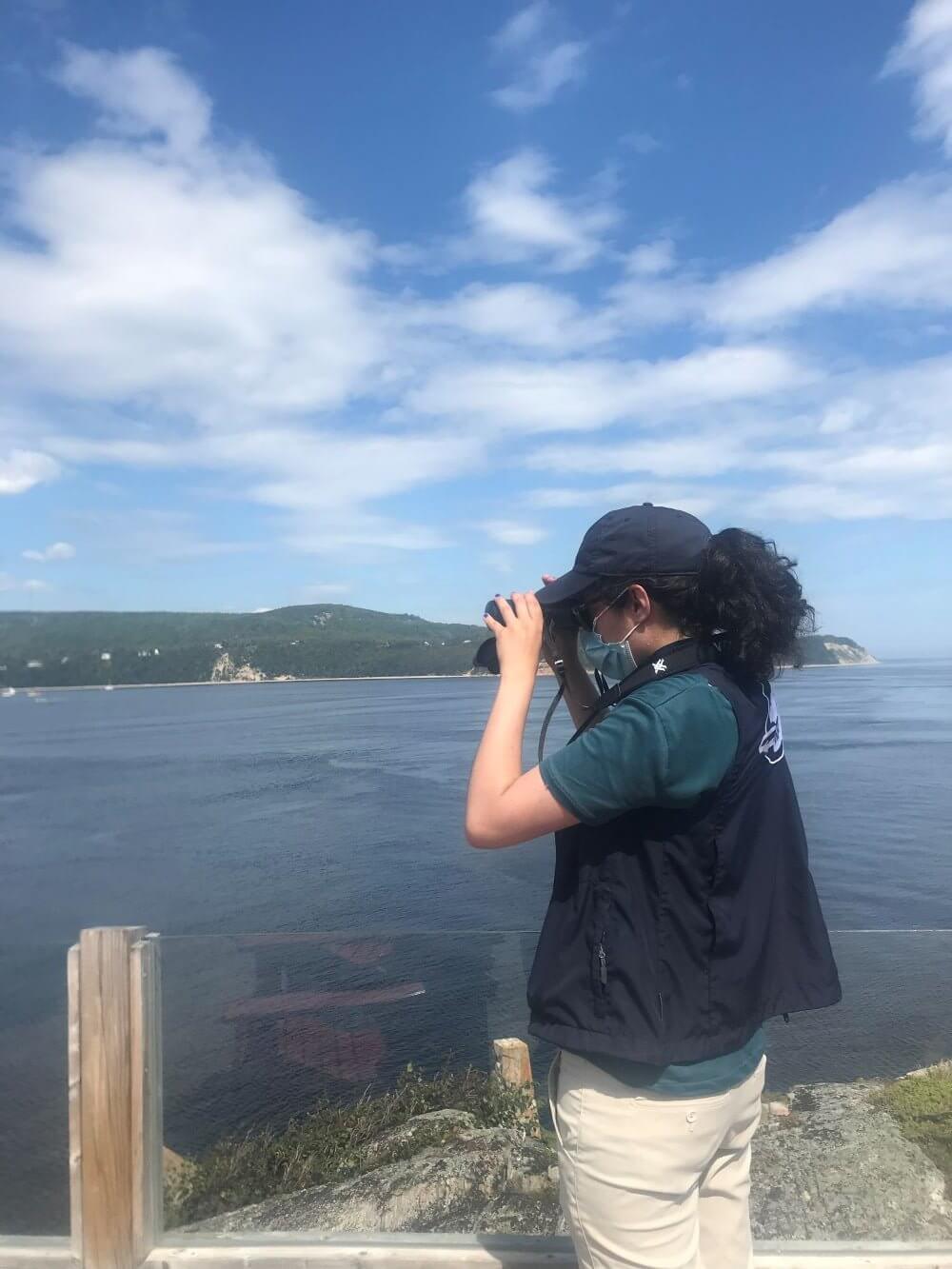Whether on water or on land, the research activities carried out by the Group for Research and Education on Marine Mammals (GREMM) represent an inexhaustible source of “whale tales”, which are often shared in our Field Notes.
However, GREMM’s educational component also has its fair share of stories! While last summer our team of naturalists hosted you at the Marine Mammal Interpretation Centre (CIMM), this year I am inviting you to join me at the Pointe-Noire Interpretation and Observation Centre, where we work together with Parks Canada.
Morning promises
9:20 a.m. On board the ferry, I leave Tadoussac on my way to Baie-Sainte-Catherine. A blanket of fog casts a veil over the mouth of the Saguenay; I can barely make out the other shore. There aren’t many of us on the boat, but I soon see I have companions of a different sort: three small white backs surface in front of me, like a promise of more sightings yet to come. Once I arrive in Baie-Sainte-Catherine, I walk along Route 138 and I’m still able to keep my eyes on the belugas, which seem to be heading toward the St. Lawrence Estuary. A few rays of sun pierce through the mist; things look promising.
10 a.m. The Pointe-Noire observation site is officially open, but visitors are slow to arrive. I’ve already put my things inside, unlocked the washrooms, and unpacked my gear: binoculars, a cetacean encyclopedia, and various panels on the whales, birds, topography and history of the site. I wait upstairs, near the house where keeper Louis-Joseph Therrien and his family resided until 1981. More than just a lookout or a place to relax, Pointe-Noire has been guiding sailors since the 19th century, first thanks to Cap de la Boule, an easy-to-spot rocky shore, then with range lights and a fog horn. While the site still retains its role as a navigational aid, it is now visited each year by thousands of visitors who come to appreciate its vistas and observation opportunities.
Life out of the water
10:30 a.m. Footsteps resonate on the wooden gallery and announce the arrival of the first visitors. “Bonjour! Hello! Welcome to the Pointe-Noire Interpretation and Observation Centre!” Already, they’re oohing and aahing over how striking the landscape is. In a single glance, one can see the tiny village of Tadoussac, the comings and goings of ferries, the mouth of the Saguenay and, to our right, the vast expanse of the St. Lawrence. I immediately start getting asked about marine mammals: “Have you seen any whales today?” I tell them about my morning observations and take the opportunity to talk about belugas, the only cetacean that lives year-round in the St. Lawrence, whose population is estimated to number around 900 individuals and which is frequently seen in these parts. Amongst other things, I am asked about its weight, size, dive time and “endangered” status. As I field their questions, I lead them to other viewpoints of the site at the bottom of the stairs, all while keeping my eyes peeled for potential animals or spouts.
1 p.m. But whales also teach us to be patient. Over the next few hours, dozens of visitors come and go without seeing any sign of cetaceans. This is an opportunity to direct their attention to other types of observations, including those of the many birds that frequent Pointe-Noire and its surroundings such as the cormorants that fly close to the water, singing white-throated sparrows or common eiders near the shoreline. In the trees, one can sometimes spot a large porcupine clinging to the branches and causing them to severely sag. Pointe-Noire is full of life if you know where to look; part of my job is to point curious visitors in the right direction.
Highlight of the show
15h. Malgré l’absence des cétacés, les visiteurs ont tendance à s’attarder sur le site. Le brouillard s’est maintenant complètement dissipé; aucun nuage à l’horizon. Une famille en profite pour pique-niquer sur l’une des tables en bois. Un couple paresse au soleil dans les chaises rouges de l’héliport. Je scanne l’horizon avec mes jumelles, les baleines pourraient surgir autant du Saguenay que de l’estuaire.
«Bélugas à 13h!» Ce n’est pas moi qui les ai repérés, mais ma collègue Florence venue me donner un coup de main en après-midi. Devant la Pointe-Rouge de Tadoussac, deux points blancs éclatants apparaissent et disparaissent. Les regards se plissent, les parents tentent de montrer – sans succès – les animaux à leurs plus jeunes enfants. Pour plusieurs d’entre eux, il s’agit d’une première rencontre avec les bélugas.
As most of our gazes track the animals in the distance, the sound of an exhalation makes our heads spin. Barely 20 metres from shore, two mothers, their calves and juveniles arrive from the Saguenay. Through the clear water, we can make out the white and grey bodies of the older ones and the small grey, wrinkled heads of this year’s calves. No need to go out on the water to see belugas: at Pointe-Noire, they come to us. We stop chatting in order to fully soak up this experience, which is just as moving for the guides and interpreters as it is for the visitors. After a few minutes of silence interspersed with spouts, I take advantage of these observations to explain to them the changes in beluga colouring as the animals go through the different stages of their development (article in French).
The finale
5:00 p.m. Already, a day that ultimately turned out to be rich in observations and emotions is drawing to a close. I make sure the doors to the keeper’s house and the washrooms are locked before taking Route 138 back toward Tadoussac. I’m in no hurry to arrive: the Fjord is bathed in a golden light and a breeze blowing off the St. Lawrence is refreshing. And as if to vindicate my slow pace, a feeding minke whale appears just as I reach the ferry. This time, I enjoy the show, which never grows old.
Special thanks to my dear colleagues Aurélie, Diane, Florence, Jennifer and Sarah for their stories and companionship.










